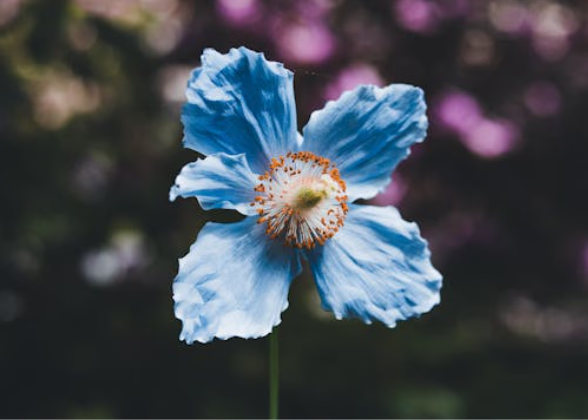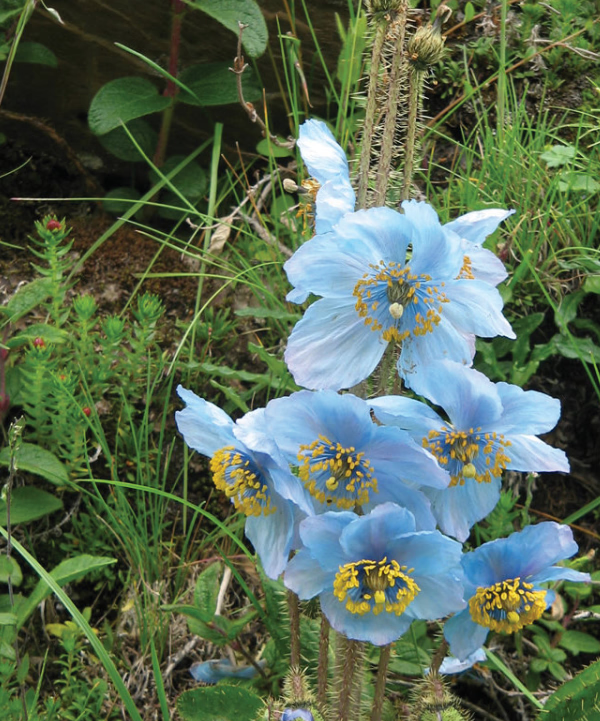
In Bhutan, stunning landscapes meet rich traditions. Here, you can find their history and modernity blending perfectly. But there's more to this Himalayan kingdom than meets the eye. Tucked away in its mountains is a symbol that captures the very essence of Bhutan.
In this blog, we'll dive into the story of Bhutan's national symbol—not just about beauty but also the country's heritage and spirit.
Whether you're a nature lover, a culture buff, or just curious about what makes Bhutan unique, stick around. You're in for a fascinating journey that reveals the deeper meaning behind one of Bhutan's most treasured emblems.
What Is The National Flower Of Bhutan?
The natural beauty of Bhutan, a small Himalayan kingdom, is often represented by various symbols, one of which is its national flower, the Himalayan blue poppy. The national flower of Bhutan is the Blue Poppy, scientifically known as Meconopsis grandis.
This striking flower, with its vivid blue petals, is a rare and enchanting sight and holds deep cultural and spiritual significance for the Bhutanese people. In this article, we’ll explore everything about the Bhutan national flower, its origins, significance, and why it stands out as a symbol of Bhutan’s natural splendor.
The Unique Beauty Of The Blue Poppy
The Blue Poppy is an extraordinary flower that thrives in the harsh, high-altitude environments of the Eastern Himalayas.
Known scientifically as Meconopsis grandis, it features mesmerizing blue petals, which can sometimes appear in shades ranging from pale sky blue to deep violet, captivating anyone fortunate enough to see it in its natural habitat.
It’s not just the color that makes the Blue Poppy special; the flower’s delicate, papery texture and golden-yellow center further enhance its ethereal beauty.
Habitat And Growth Conditions
Bhutan’s national flower typically grows at altitudes between 3,500 and 4,500 meters (11,500 to 14,800 feet), where the air is thin and the weather conditions are harsh. It is found in eastern Bhutan, particularly in the remote area of Sakteng.
The Blue Poppy is a perennial plant, meaning it lives for over two years and usually blooms from May to July. It thrives in moist, shaded areas with well-drained soil, often found in lush pastures and rocky mountain terrain.
Additionally, it can occasionally be located on the sunny edge of sub-alpine forests. The flower’s ability to endure such tough conditions, growing alongside tall herbs above the treeline, reflects the resilience and strength of Bhutan’s natural environment.

Discovery And Scientific Classification
The Blue Poppy was first discovered in 1933 by British botanist George Sherriff in Bhutan’s remote and rugged terrain. The collaborative research effort between the National Biodiversity Centre of Bhutan and the Blue Poppy Society of Japan has led to the discovery of new species of blue poppy.
Its discovery caused quite a stir in the botanical world, as it was unlike any other poppy known at the time. Due to its large, grand appearance, the flower was given the scientific name Meconopsis grandis.
Today, the Blue Poppy is one of the most sought-after flowers for botanical gardens and collectors around the world, though its cultivation outside its native habitat remains challenging.
Recent research has led to the reclassification of Meconopsis grandis subspecies, now recognized as a distinct species known as Meconopsis gakyidiana.
What Is The Blue Poppy's Cultural Significance?
Symbol of Purity and Spirituality
In Bhutanese culture, the Blue Poppy is more than just a breathtaking flower; it is a symbol of purity, spirituality, and peace. The flower's rare and elusive nature is often associated with the country's deep-rooted spiritual traditions.
As a predominantly Buddhist nation, Bhutan views the Blue Poppy as a symbol of the unattainable or spiritual path that requires dedication and perseverance.
The flower's bloom in the harshest of conditions is also seen as a metaphor for spiritual enlightenment, which often comes after overcoming significant obstacles.
Representation Of National Identity
The Bhutan national flower represents the nation's identity and the harmony between its people and nature.
The Blue Poppy's resilience and ability to thrive in extreme environments resonate with Bhutan's national philosophy of Gross National Happiness (GNH), which emphasizes the balance between material and spiritual well-being.
The flower's beauty and rarity also symbolize the uniqueness of Bhutan, a country that has managed to preserve its resources and natural environment amidst modern challenges.
Role In Traditional Medicine
Apart from its symbolic significance, the Blue Poppy also holds a place in Bhutan's traditional medicine. The plant is believed to have medicinal benefits, and various parts of the flower are used in traditional remedies to treat inflammation and digestive disorders.
Though scientific research on the medicinal benefits of the Blue Poppy is limited, its use in conventional practices adds another layer to its importance in Bhutanese culture.
Bhutan's National Flower In Art And Literature
The Blue Poppy's stunning appearance and cultural significance have made it a popular subject in Bhutanese art and literature.
It is often depicted in paintings, embroidery, and handicrafts, symbolizing the country's natural beauty and spiritual depth.
In Bhutanese literature, the flower is sometimes mentioned in poems and folk tales, where it serves as a symbol of unattainable beauty or spiritual aspiration.
The Blue Poppy In Modern Bhutanese Culture
In contemporary Bhutan, the Blue Poppy continues to be a symbol of national pride. It is featured in various cultural and national events, and efforts are made to protect and conserve this precious flower in its natural habitat.
The Blue Poppy is also used as a motif in modern Bhutanese fashion and design, blending traditional symbolism with contemporary aesthetics.
Conservation Efforts
As Bhutan’s national flower, the Blue Poppy is protected by law, and efforts are made to ensure its conservation. The Himalayan cypress, Bhutan's national tree, is also a significant cultural and natural symbol, representing resilience and the connection to Bhutanese traditions and environmental conservation.
Bhutan’s government and various environmental organizations are actively involved in preserving the natural habitats where the Blue Poppy thrives.
These efforts are crucial in maintaining the delicate balance of Bhutan’s ecosystem and ensuring that future generations can continue to admire this beautiful flower in the wild.
Conclusion About The National Flower Of Bhutan
The Blue Poppy, Bhutan's national flower, embodies the country's blend of natural beauty, spiritual depth, and cultural heritage. Its vivid blue petals, growing in the rugged landscapes of the Himalayas, remind Bhutan of its commitment to serving its environment and cultural identity.
The Blue Poppy will continue to inspire and captivate the hearts of those who encounter it, whether in the wild or through the rich cultural tapestry of Bhutan.
If you’re eager to experience the beauty of Bhutan firsthand and explore the breathtaking landscapes where the Blue Poppy blooms, let Druk Asia guide you on an unforgettable journey. Book your adventure with Druk Asia today and see why Bhutan is truly a destination like no other.
Frequently Asked Questions About The National Flower Of Bhutan
Is The Blue Poppy Used In Bhutanese Festivals Or Ceremonies?
While the Blue Poppies are not specifically used in festivals, they are highly revered in Bhutanese culture and often feature in local artwork, traditional clothing designs, and as symbols during cultural events.
Are There Any Myths Or Legends Associated With The Blue Poppy In Bhutan?
In Bhutanese folklore, the Blue Poppy is sometimes associated with mystical and spiritual themes. It represents unattainable beauty or the idea of spiritual enlightenment that can be achieved through perseverance.
Can Visitors See The Blue Poppy In Bhutan?
Visitors can see the Blue Poppy in its natural habitat during trekking expeditions in Bhutan's high altitude, especially between May and July, when the flower is in bloom.
Are There Any Conservation Efforts In Place For The Blue Poppy In Bhutan?
Yes, Bhutan has implemented conservation efforts to protect the Blue Poppy, including the preservation of its natural habitats in national parks and other protected areas.
Is It Possible To Grow The Blue Poppy Outside Of Bhutan?
While it is possible to cultivate the Blue Poppy outside of Bhutan, it requires very specific conditions, including cool temperatures, high humidity, and well-drained soil, which makes it challenging for most gardeners.
